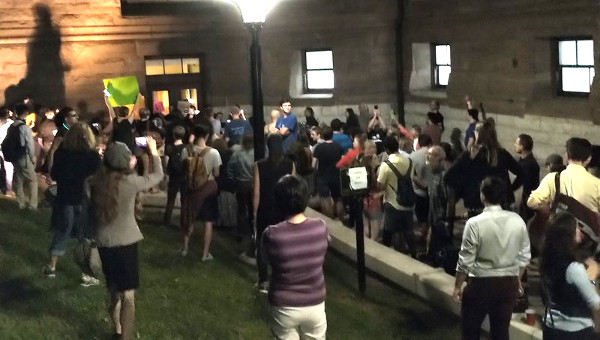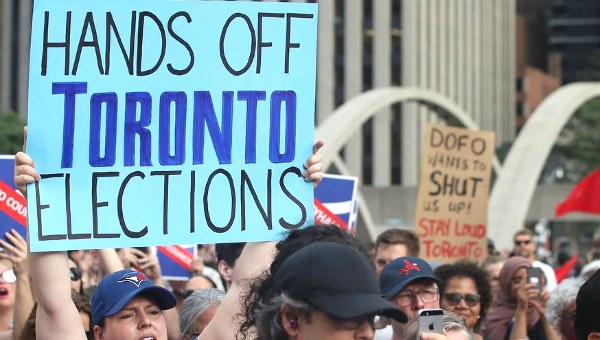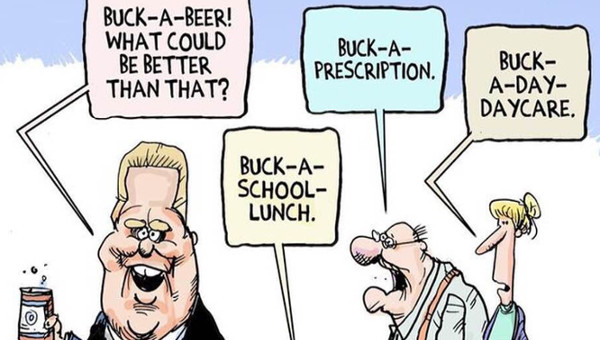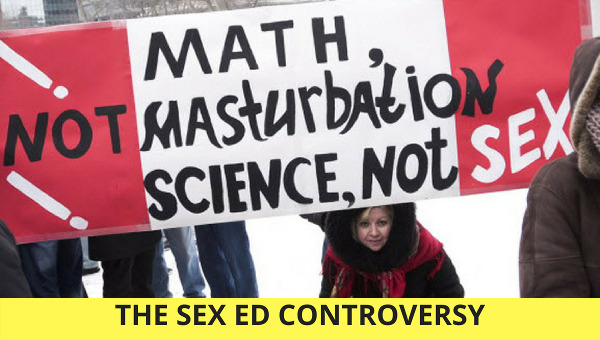Harper’s Bunker: The State, Neoliberalism and the Election
The manner of governing of Stephen Harper’s Conservative government might be characterized as a paradox with a purpose. A sharp centralization of authority over decision-making and political management in the executive branches of the state – particularly to augment policing, warmaking and market-enhancing administrative capacities – is accompanied by an equally focused policy agenda that seeks to hollow out the redistributive role of the Canadian federal state. This simultaneous centralization and decentralization is a key feature of the process of state restructuring under neoliberalism.
It is not a matter of bypassing or weakening the state in favour of markets in general, but a change in the form of the state: the executive of the state is strengthened relative to parliaments and participative bodies; state economic apparatuses facilitating the internationalization of capital and market processes to bolster capital accumulation are given policy precedence over redistributional and regulatory departments of the state; decentralization is pursued as an administrative and constitutional agenda to weaken further redistributional and regulatory policies while centralized policies for the protection of free trade, commerce and private property are adopted; and the internal processes of all levels of the state are increasingly commercialized, privatized, insulated from democratic accountability and subordinated to capitalist imperatives and agencies.
The phenomenon of ‘centralized decentralization’ was first observed with respect to the British experience with Thatcherism. It was observed that the power of the state was in fact becoming increasingly concentrated – ‘free market, strong state for these iron times’ – in particular state apparatuses closely controlled by the executive branch. This centralization of power was necessary, politically speaking, as a means to drive through an agenda to restructure the economy, defeat the trade unions, erode the welfare state and strengthen control and political usage of the coercive apparatuses of the state. The Thatcher-era Conservatives understood that state power was a necessary element to restructure the state and economy alike, as well as its relations with different aspects of civil society.
The parallel process in Canada had its origins with Brian Mulroney’s Conservative government of the 1980s (although the Liberal governments of Pierre Trudeau first brought neoliberalism to Canada, and he began administrative restructuring in the last years of his regime). It gained a great deal of momentum under the Liberal government of Jean Chrétien, and the massive restructuring budgets of Paul Martin of the mid-1990s.
What Canadians have witnessed in the two odd years of the Harper regime in Ottawa is a variation on these themes. There is a further centralizing of power at the centre of state, and in key state economic apparatuses, as neoliberalism ‘hardens’ in response to the current economic crisis and the military impasse of the wars in the Middle East. As well, a new agenda for decentralization of social and redistributional policies of the federal government appears to be forming. It is in this light that some of the recent developments of the Conservative minority government need to be read as they prepared themselves for the fall federal election of October 14, and their hoped for subsequent agenda in a new Parliament.
Centralizing Power at the Summit of the Canadian State
Even by the standards of other liberal democracies, the Canadian state, burdened by the vestiges of British colonialism, is among the least democratic. The immense powers previously held by the colonial-era Governor-Generals have, over time, been transferred to the Prime Minister Office (PMO). This includes the power over appointments to the cabinet and to important non-elected positions within the state apparatus, most important through the extension of administrative and political controls over the Privy Council Office (PCO – the overseer of the bureaucracy). The result is that the prime minister and those individuals who inhabit the PMO wield immense power – Canada’s elected dictatorship – over the workings of the Canadian state.
This political-institutional legacy substantially enables the centralization of power within the Harper government, as it did for prior Mulroney and Chrétien regimes. This process has had several dimensions including the building up of separate administrative and policy capacities, the formation of a few key (and most often secretive) operational committees, placement of key political personnel in the PMO and PCO, and a narrowing of persons and institutions which can influence policy direction.
In terms of the elected and appointed officials constituting the executive offices of the Canadian state in the current regime, what is most evident is the number of former ‘Common Sense Revolutionaries’, from the hyper-neoliberal Ontario Government of Mike Harris of the 1990s, now at the centre of the Harper government.
Minister of Finance Jim Flaherty served in prominent positions in both the Harris and the successor Ernie Eves’ governments, including as minister of labour, corrections, attorney general, finance, and deputy premier. He was clearly identified with the hard right within the Common Sense Revolution and aggressively attacked Eves in the leadership battle to succeed Harris as party leader and premier as too moderate.
John Baird, the current Minister of Environment, was the social services and energy minister through the Common Sense Revolution years. There he took a hard line on young offenders and took every opportunity to boast that the rapidly dropping number of social assistance recipients was evidence of the success of the Harris government’s social and economic policy.
When asked where these tens of thousands of former welfare recipients were ending up he admitted not having a clue.
Tony Clement, who is responsible for the health portfolio, is another Common Sense Revolution veteran who at various times held the transportation, environment, housing, and health portfolios. Peter Van Loan, the Conservative House leader, was president of the Ontario Conservative party under Harris.
And, behind the scenes, Harper recently appointed as his chief of staff in the Prime Minister’s Office, Mike Harris’s former chief policy advisor and also chief of staff, Guy Giorno. This is in addition to a bevy of lesser known young Common Sense Revolutionaries who found their way into the Harper government as policy and communications specialists in various minister’s offices.
Taken together, these individual conservative partisans and several of their former colleagues were all central players in Ontario’s Common Sense Revolution. They left Ontario a stunningly different place than when they entered government in massively restructuring government and bolstering corporate power. A similar project is under construction in Ottawa to pursue more radical neoliberal policies, slowed mainly by the realities of minority government. Still, the Harper government is two and one-half years old and there are clear signs which look eerily like Ontario in the 1990s. And like Harris in Ontario, the Harper agenda is to embed neoliberalism and social conservatism as the fused governing philosophy in Canada whatever party is in power (something that the Harris project was quite successful in Ontario, including having it embedded in Toronto municipal government although nominally run by a social democratic Council block).
There are, of course, ‘insiders’ of note who have no link to Ontario’s Common Sense Revolution, such as Foreign Affairs Minister David Emerson and Defence Minister Peter Mackay. By virtue of their current portfolios they are responsible for policy fields of considerable importance to the Harper government as it aligns Canada to an unprecedented extent to the ambitions of American imperialism. Emerson in particular is interesting in terms of his background as Deputy Minister of Finance in the British Columbia government of Bill Vander Zalm but also as a director, prior to election to Parliament in 2003, of Macdonald, Dettwiler and Associates (MDA). MDA specializes in data and information processing as well as various satellite technologies which have applications to missile and other weapons systems. Moreover, MDA’s American parent company, Orbital Sciences, is a major missile defence contractor.
As Industry Minister in the Liberal Paul Martin government (Emerson crossed the floor to join the Conservatives shortly after the Conservative win in 2006), Emerson lobbied for a Canadian aerospace industry strategy where he openly recognized the “potential industrial cooperation opportunities for Canada associated with Ballistic Missile Defence” (The Hill Times, November 22-28, 2004). Fast-forward to the Conservative Budget of 2008 and a line of continuity is apparent. A ‘Canada First Defence Strategy’ was proposed entailing a $12 billion increase in defence spending over the next 20 years and using public money to forge a “new relationship with industry,” as the budget speech referred to it.
Neoliberals and the Personnel of the Federal State
The changing nature of the Canadian state cannot be ignored in all of this. The long-standing doctrine in public administration that the state is neutral serves to mask a rather different reality. Forty years ago British political scientist, Ralph Miliband, launched a debate regarding the nature of the state wherein he argued the state is an instrument of the ruling classes. That is to say, the liberal democratic state is a capitalist state in that it is dominated by the ruling classes via the elites who control the state, and the way that departments of government are subordinated to business interests. The relations between the state and corporate interests, however, do not always take the same institutional and political forms. Today, the state and its institutions are taking new organizational and corporate forms that are organically linked to the neoliberal project. This can also be seen in the circulation of state elites under Harper.
A case in point is what is happening to the very uppermost echelons of the federal state elite. In March 2006, exactly one month after being sworn in as Prime Minister, Harper appointed Kevin Lynch to the top position in the Canadian public service. An economist by education, he had a long career in the ministries of finance and industry as well as the Bank of Canada. Within six months Lynch had removed a number of senior bureaucrats. It is purely speculative to attribute motive to the removals and ensuing promotions but alignment with the agenda of the government is always at least a part of such moves.
Lynch’s predecessor as head of the public service, Alex Himelfarb, while no leftist, was a traditional public servant who saw the role of senior public servants as one of offering policy advice, even unwelcome policy advice, to the cabinet and prime minister. Himelfarb’s background as a former professor of sociology and then as a public servant associated with social policy initiatives, was probably simply not a good fit in assisting the Harper government pursue its neoliberal economic agenda. Moreover, a pluralist approach to policy advice was not welcome in the Harper state.
As with the Common Sense Revolution in Ontario, the latitude for policy development narrowed substantially. The role of the broad public service – apart from the core at the executive summits in the economic or security apparatuses – has been recast as one of simply implementing the priorities of the government without regard to alternatives or warnings respecting potential downsides. It is this type of neoliberal bureaucratic restructuring that partly accounts for, on the one hand, the scandal of the meat inspection processes in Canada as it moved toward industry self-regulation, and, on the other, the autonomy and the lack of democratic accountability of any of the measures of the Bank of Canada, under the leadership of Governor Mark Carney (with his work lineages to Goldman Sachs and its derivatives trading arm), during the current global credit meltdown.
According to a well-placed Ottawa consultant, the centralization of the policy-making function in the PMO has led to the loss of several senior policy managers, especially at the assistant and deputy minister level. With less interesting and more distasteful work to do – such as the massive gutting of funding of cultural programmes in the quiet of August, many public officials, at both senior and intermediate levels, have departed. This is a crucial way that neoliberalism has consolidated across the senior levels of the Canadian state. Neoliberals have consistently been moved into key bureaucratic posts, in a sense forming themselves as ‘organic intellectuals’ of the neoliberalization of the state. The Harper government is continuing this process in a more thorough-going reorganization of state personnel.
Centralization of Power
for Decentralization of Social and Economic Security
It is important to see the recruitment of the many political and administrative leaders of the Common Sense Revolution, and the extensive dismissal, circulation and conscription of new state personnel, to the Canadian state with a sharpening of neoliberalism in Canada. This is a strengthening the central executive and organs of the Canadian state. They are putting in place the political and administrative capacities to pursue a further fundamental decentralization of the redistributional capacities of the state. This is consistent with neoliberalism, the legacy of the Reform and Alliance Parties that Harper has sustained, the Conservative strategy for gaining political space in Québec and the agenda the Harrisites have brought to Ottawa.
The fundamental premise of the postwar ‘social contract’ in Canada, as elsewhere among the northern capitalist states, was establishing some minimal floor of social and economic security. The period of post-war and depression reconstruction was best captured by the 1943 Report on Social Security which would inform the next 30 years of largely federally-driven welfare state building in Canada. This redistributional bargain was built into the institutions of federalism in Canada, particularly through federal transfers but also by Federal government administrative and policy oversight.
Today, in contrast, the Harper government is proposing to build on the defunding and deconstruction which took place under the Mulroney and Chrétien governments. Together these governments brought Canadians a deepening insecurity through the effective constitutionalization of free trade and an unprecedented retreat of the federal state from the funding of social programs. Recent suggestions that the provinces may be provided more economic autonomy is a program to further constrain what is left of the Canadian social security state. As it is the social program fabric of Canada, given that the provinces are responsible for program delivery, is increasingly a hodge-podge of unequal access, quality and coverage. Greater decentralization without fiscal capacity, that is the ability to fund programs, will assuredly translate into greater inequality. No doubt, as has been the case elsewhere, devolution to subnational levels of government, whether local or provincial, sets the stage for a race to the bottom as these jurisdictions compete with each other to win investment and curry favour with capital by cutting taxes and rolling back social security.
The centralizing agenda of Harper’s Conservative government, particularly as it relates to political and state personnel, has its counterpart in this decentralizing agenda with respect to social and redistributional policies. It is one of the key areas that Canadian neoliberals are keen to act further upon. This is framed in terms of the Conservative’s ‘strict constitutionalism’ in assessing the federal division of powers in Canada: the federal government should not be involved in policy areas, such as health, education, welfare, culture, that are allocated as provincial powers in the Canadian constitution. This is the neoliberal competition state further displacing the welfare state. It is also Harper’s vision for Canada, and forms the basis for the Conservative election platform.
The 2008 Federal Election
While neoliberalism in Canada, as throughout the world, is increasingly discredited, and has less and less popular appeal, it continues on inside state institutions and power structures. Economic crises and military debacles have not yet broken it. The opposition parties all reject, to varying degrees, some of the worst aspects of the Conservative government. On this basis alone, it will be worthwhile campaigning to defeat the Conservative as one of the most egregious governments Canada has had in 80 years in terms of domestic policy, and the most supine ever in having Canada fulfill its role as faithful ally of American imperialism. Yet, it cannot be ignored that the political scene in Canada is all but absent of political alternatives to neoliberalism: all of the parties have accepted the ‘new realities’ of Ottawa, and none is attempting to build an anti-neoliberal politics.
It is pure fantasy to suggest, as many have been doing, that a Liberal-NDP alliance (with the Greens possibly thrown into the mix) and tactical voting would serve as a means to ‘reclaim’ Canada against the ‘neoconservatives’ of Harper. The Liberals implemented the main features of neoliberalism in Canada. And social democracy around the world has accommodated neoliberalism, as has the NDP everywhere it has held power in Canada since the 1990s. Indeed, social democracy has realigned itself in terms of its organizational basis, its policies and the political alliances it forms. As a political instrument, social democratic parties such as the NDP play as much a role in disorganizing the working class as they once did in organizing it (in Canada on the basis of a quite particular and paternalistic labourist ideology).
This is a feature of the broad collapse of the Left since 1989. In Canada, it has led to political dissent taking a variety of forms: political apathy, minoritarian radical campaigns, social coalitions, efforts to forge electoral pacts, and starry-eyed efforts at reforming the NDP. This has meant that elections have come to focus – as with the current election – on the merits of voting for the NDP as the best alternative in existing circumstances. This has held the majority opinion as the NDP remains, if ever more loosely, the only ‘labour’ party in North America and it remains the closest of all the parties to a variety of community struggles and progressive opinion on the issues of the day. These contentions still have merit.
A smaller number have been few calling for a wider electoral front to defeat the hard right of the Harper coalition, through strategic voting where the Liberal candidate has had the best chance to defeat the Conservative. This position has proven difficult to pursue in practice given non-cooperation from the parties and being simply a call for particular voting through the media (where a wider campaign is going on to simply have the NDP and the Liberals merge, given the view that the NDP’s policy stance is largely one of degree and not of kind from the Liberal Party). The strategy, moreover, has left the wider electorate (particularly ordinary workers) more confused when the same general policies continue on with the Liberals in power. The leading organization campaigning for this strategy has been the Canadian Auto Workers (CAW), and it has, no doubt, contributing to the current strategic disorientation of the CAW on both collective bargaining and political issues as its elected leadership cosied up to the Liberal Party.
The contention that the Left should take on the responsibility for the formation an electoral pact between the Liberals and the NDP, rather than campaigning for the issues and campaigns it believes in, has proven electorally fruitless and political debilitating in the past. There is no plausible reason to expect any different outcome in this election.
The features of neoliberalism that now structure the Canadian state (and that Harper’s electoral agenda seeks to deepen) do not lend themselves to easy reversal through elections or through these political forms. Discussion about electoral strategy in the context of existing political forces becomes ever more formalistic. This limiting of democratic politics, and the political disorganization of working class and social movements, have been central objectives of neoliberals. That is a crucial and most painful lesson of the last two decades.
Social transformation in the 21 century is not going to occur through a singular political rupture, or a set of reforms built into an electoral alliance, or a series of spontaneous scattered revolts. This is also the case for breaking the grip of neoliberalism as a set of socio-political relations and state structures (and not just as a set of policy ideas or an ideologically extremist defence of the market). To form an alternative to neoliberalism and the form of state it has constructed, the formation of a new social bloc, campaigning for a systemic anti-neoliberal alternative and able to contest – not even necessarily conquer – political power, is required.
The Left in Canada has been much slower than elsewhere to come to terms with this new political reality. In both more radical small political currents, key unions and social movements, there are just calls for more of the same, only better or more determined than the past. This is intellectual nonsense and increasingly politically debilitating. The current federal election provides an opportunity to defeat Harper. It also allows the Left to campaign on a series of key political demands – such as getting out of Afghanistan, a public infrastructure programme to reverse carbon emissions, settlements with First Nations, rebuilding public healthcare and education, constraints over financial capital – that can also be a foundation for its own rebuilding and re-emergence as a social force. •





